C++ 教程 - 01 基础篇
2023-12-13 20:36:40
C++介绍
-
基于C语言,继承了C的所有语法;
-
静态类型语言,需要先编译,再执行;
-
贴近底层硬件,运行速度快;
? -
支持面向对象、面向泛型,增强版的C;
-
应用领域

-
编译(Compile),编译器 将整个源代码翻译成机器码(二进制文件),一次性交给计算机执行,如C/C++;
-
解释(Interpret),由解释器将代码逐行解释为机器码,交给计算机执行,如 python/js ;
-
c++的运行
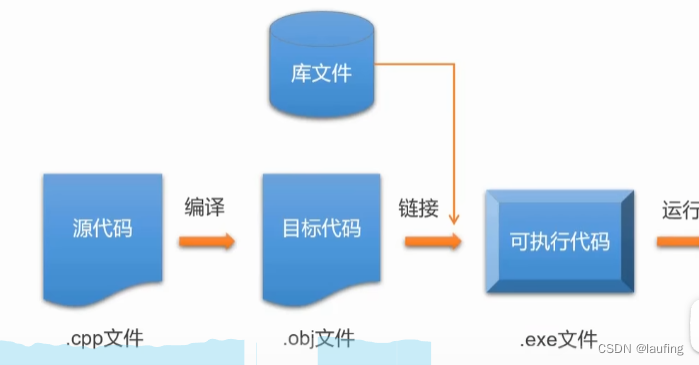
-
版本C++ 98、C++ 11、 C++ 14、 C++ 17、C++ 20
环境配置
集成开发环境Visual Studio ,编辑、编译;
下载地址
工具 -> 选项 可调整字体等
项目上右键 -> 设为启动项目,做项目切换;
Ctrl + k, c 注释;
Ctrl + k, u 取消注释;
?
第一个cpp程序
#include <iostream> // 包含头文件
using namespace std; // 使用std 命名空间
/*多行注释
int, 返回值类型
main,主函数
arr, 形式参数
{}, 函数体
*/
int main(char* arr[]) { //一个项目中仅仅一个main函数
// cout 输出 cin >> 变量 输入
// << 流输出运算符
// endl 结束一行
cout << "Hello jack" << endl; // 必须分号结束
// 系统调用
system("pause"); // 暂停
return 0;
}
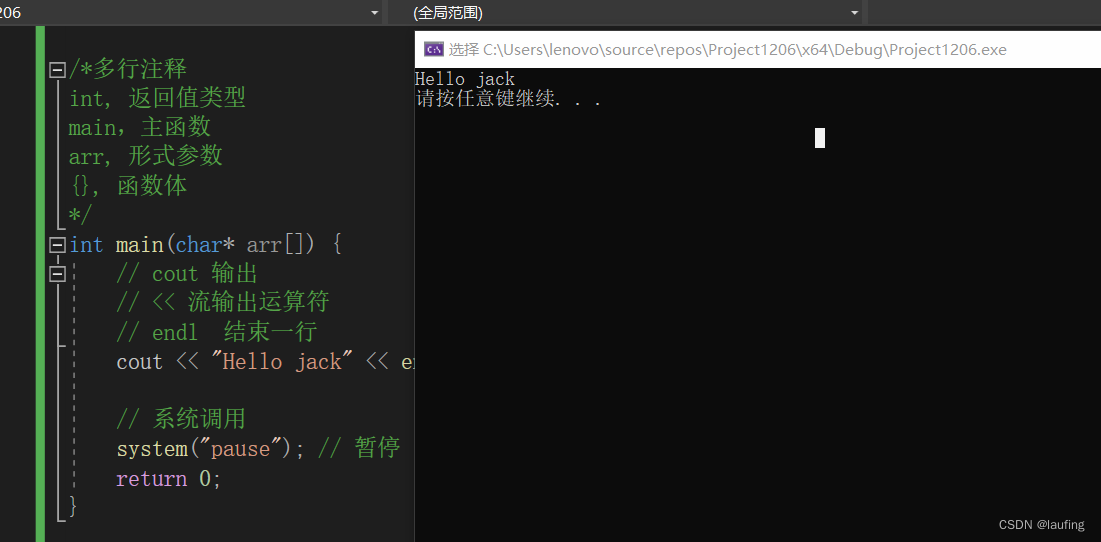
选中源码-右键-编译,可以生成.obj目标文件;
选中项目-右键-生成(build),可以生成exe文件;
查看路径如下:
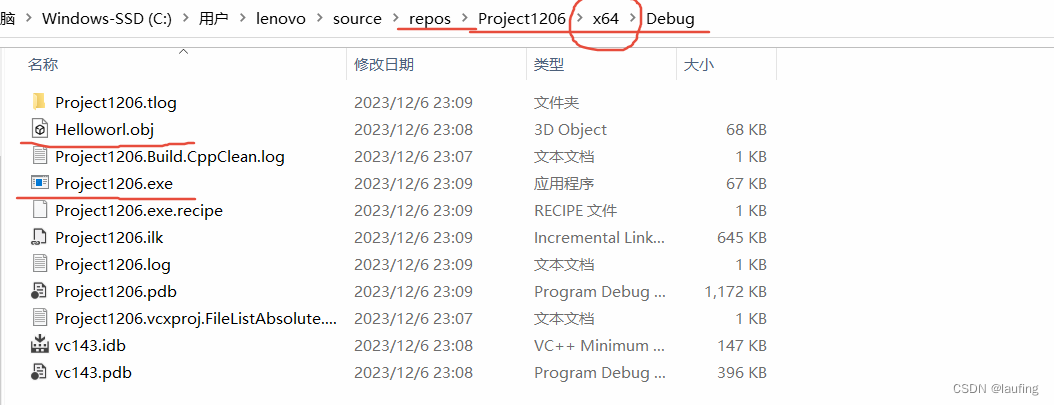
?
案例练习
- 基于函数封装实现功能;
- 输入用户名,输出欢迎信息;
#include <iostream> // 包含头文件
using namespace std; // 使用std 命名空间
// 函数封装 void 表示 函数没有返回值
void welcomeUser() {
cout << "请输入用户名:" << endl;
// C++ 支持字符串类型 而C不支持
string name;
// 输入
cin >> name;
// 输出欢迎信息
cout << "Welcome " << name << endl;
}
int main(char* arr[]) {
// 调用函数
welcomeUser();
// 系统调用
system("pause"); // 暂停
return 0;
}
也可以将该函数定义在另一个源文件中,本源文件内仅仅声明即可使用。声明如void welcomeUser(); 是没有函数体的;编译器会自动查找。
?
变量
- 声明变量,即分配内存;
- 命名以字母、数字、下划线,不以数字开头;
- 在代码块{ }内部的变量为局部变量;在所有{}外的变量为全局变量;
- 局部变量必须先初始化赋值,才可以使用;而全局变量默认初始化;
- 代码块内部,优先查找(作用域最小的)局部变量,使用 :: + 变量 访问全局变量;
#include <iostream> // 包含头文件
using namespace std; // 使用std 命名空间
// 定义枚举类型
enum Sex
{
MALE, // 默认从0开始
FEMALE
};
int main(char* arr[]) {
// 整型定义
int age; // 变量的声明
age = 23; // 初始化赋值
// double
double score = 79.534; // 声明并赋值 为变量定义
float scoreF = 60.8f;
// 字符串定义
string name = "jack";
string fullName = name + "li"; // 字符串的拼接
// 布尔
bool isGood = false;
// 枚举
enum Sex sex = MALE; // 定义 并赋值
// 输出
cout << "姓名:" << name << endl;
cout << "全名:" << fullName << endl;
cout << "性别:" << sex << endl;
cout << "年龄:" << age << endl;
cout << "分数:" << score << endl;
cout << "是否好学生:" << isGood << endl;
// 系统调用
system("pause"); // 暂停
return 0;
}
- 变量基本类型(本质占用多少内存空间)
- char, 字符类型 单引号+单字符;1byte;对应ASCII码整数值;
- short,短整型 2bytes
- int ,整型 2-4bytes,注意数据溢出,超出范围循环到另一端;一般使用int;
- long,4bytes
- long long 8bytes
- unsigned short/int/long/long long 无符号(非负);
- unsigned char 无符号的字符
- float,单精度浮点型 4bytes
- double 双精度,8bytes
- string,字符串
- bool,true/false,本质为整型
- void 空类型;
- 整数字面量默认为int; 可以后缀指定 LL 长整型/ ULL无符号长整型
- 小数字面量默认为double; 指定后缀 f -> float,L -> long double;
- 字符串的字面量是字符的数组;
?
- 自定义类型
- enum,枚举
- struct,结构体
- union,共用体
- sizeof 查看占用内存大小
- sizeof age
?
- sizeof age
常量
- const 类型 常量名=赋值;值不可更改;
- #define ABC 5 宏定义常量;
- 常量值不可更改
?
关系运算符
- <、<=、 >、>= 优先;
- ==、!= 次之
- 表达式返回bool类型
逻辑运算符
&& 同true 则为true ,第一个为false,则不再计算第二个条件;
|| 有一个true 则返回true ,第一个为true,则不再计算第二个条件;
!取反
优先级
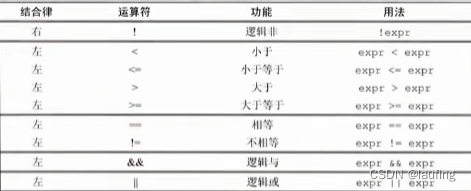
条件运算符
- 表达式 ?值1 :值2
- 表达式为true,则取值1;否则取值2;
- 优先级较低,一般使用()包裹;
位运算符
- ~ 按位取反;
- << 按位左移、>> 按位右移; 如 int a = 5; a << 2; 一般无符号的数左移、右移;
- & 按位与,同1则为1;
- | 按位或,有1则为1;
- ^ 按位异或,相同则为0,不同则为1;
- 优先级从上到下依次降低;
类型转换
- 隐式转换,
- 短的数据类型向长的数据类型转换;如int -> long long; 4 + 5.5 这里4转为double
- short/char/bool 一般会转为int;
- 判断时,0转为false,非0转为true;
- 赋值时,右侧值类型转为左侧变量的类型;
- 强制转换,长的类型向短的类型中转换;
- int age = 5;
- double aa =(double)age; // C风格
- double bb = double(age); // C++风格
- static_cast<double>(age)
分支
- if …else
if (表达式) {}
if (表达式) {}
else if (表达式) {}
else {}
- switch
int age = 5;
switch(age){ // 必须传入数值
case 1: 语句;break;
case 2: 语句;brea;
default: 语句;
}
案例1:输入一个人的姓名,分数,输出他的平分等级;
>=90 优秀;
>=80 良好;
>=70中等;
>=60及格;
否则,不及格
#include <iostream>
using namespace std;
int main() {
// declare
string name;
double score;
cout << "输入姓名:" << endl; // endl换行
//获取输入
cin >> name;
cout << "输入分数:" << endl;
cin >> score;
// 判断
if (score >= 90) {
cout << name << ":优秀" << endl;
}
else if (score >= 80) {
cout << name << ":良好" << endl;
}
else if (score >= 70) {
cout << name << ":中等" << endl;
}
else if (score >= 60) {
cout << name << ":及格" << endl;
}
else {
cout << name << ":不及格" << endl;
}
// system("dir");
system("pause");
return 0;
}
?
案例2: 输入绩效等级,输出奖金数额;
使用switch
#include <iostream>
using namespace std;
int main() {
// declare
char level;
cout << "输入等级:" << endl;
cin >> level;
switch (level) { // 传入数值
case 'A': cout << 1000 << endl; break;
case 'B': cout << 500 << endl; break;
case 'C': cout << 300 << endl; break;
default: cout << "没有奖励" << endl;
}
// system("dir");
system("pause");
return 0;
}
?
循环
- while
- do…while
- for
C是面向过程,为扩展C的功能,开发出了C++,扩展了面向对象、基于泛型的操作;
C的所有语法在C++中基本都可以使用;
由于C++的复杂性,基于C++ 实现了java语言,在保留好用的语法的同时,进行了不好的语法的修改;
?
while循环:
#include <iostream>
using namespace std;
int main() {
// declare
char level;
int i = 3;
// 用户循环输入
while (1) {
// 异常捕获
try
{
cout << "输入等级:" << endl;
cin >> level;
switch (level) {
case 'A': cout << 1000 << endl; break;
case 'B': cout << 500 << endl; break;
case 'C': cout << 300 << endl; break;
default: cout << "没有奖励" << endl;
}
--i;
cout << "i:" << 5 / i << endl; // 除0会退出进程
continue; // 继续下次循环
}
catch (const std::exception&) // 异常捕获 与java js类似
{
cout << "捕获异常" << endl;
break; // 结束循环
}
}
// system("dir");
system("pause");
return 0;
}
?
do…while:
int i = 10;
do {
cout << "current i:" << i << endl;
--i;
}while(i > 0);
?
for循环:
// C 的用法
int i;
for(i=0; i < 10; i++){ // 满足i<10,则执行代码块,最后执行i++,再判断是否满足条件
cout << "current i:" << i << endl;
}
// 遍历数组元素 同java
int arr[] = {1, 2, 5, 9};
for (int e : arr) {
if (e % 5 == 0) {
continue; // 继续下次循环,后面的代码不再执行
}
else if(e / 3 == 3){
break; // 结束循环
}else
cout << e << endl;
}
// 最终输出 1 2
 ;
goto 标签: 跳转到语句块,不推荐使用
#include <iostream>
using namespace std;
int main() {
goto laufing; // 语句块 跳转 windows批处理支持goto
// 声明语句块
laufing:
cout << "input your name:" << endl;
string name;
cin >> name; // 直接输入空格,不会停止扫描,输入字符串后遇到空格则停止
// name.empty() 是否为空
// name.length() 长度
// name.at(idx) 获取对应索引处的字符
// name.substr(start_idx, count) 从idx索引开始,截取count个字符
// name.find(sub_string) 返回找到的第一个位置的索引,找不到则返回一个很大的数字
// name.rfind(sub_string) 从右边开始查找,返回第一个的起始索引
// name.clear() 清空该地址的字符串
if (name.empty()) { // 字符串为空
cout << "empty name" << endl;
goto laufing;
}
else if (name.length() < 2) {
cout << "to short" << endl;
goto laufing;
}
else
{
cout << "idx 0:" << name.at(0) << endl;
cout << "substr:" << name.substr(1, 3) << endl;
cout << "find:" << name.find("ja") << endl;
cout << "find:" << name.rfind("ja") << endl;
name.clear();
cout << "clear:" << name << endl;
}
// system("dir");
system("pause");
return 0;
}
?
程序调用
- 源代码打断点,直接在对应的行处点击;再次点击取消断点
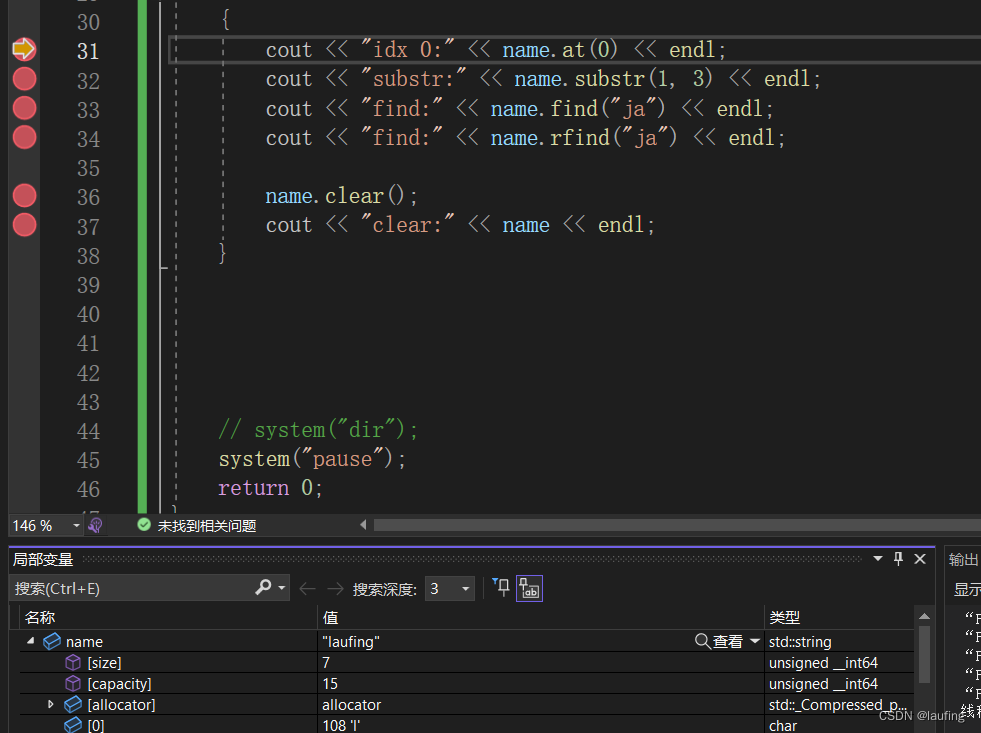
- 调试快捷键
- F5 开始调试,shift+F5 结束调试,Ctrl+F5 直接执行(不调试)
- F11 逐行执行,shift+F11 到下一个断点;
- shift+F9 快速监视变量值,选中一个变量->shift+F9,点击‘添加监视’

- 也可以点击菜单栏的‘调试’;
?
综合案例
- 输入一个自然数 n,判断是否为质数;
- 只能被1和自身整除,则为质数;
- 1和自身 不用判断,可以取 2 -> n / 2 之间的值,依次判断是否被n整除;
- n特别大时,为优化性能,可以取 2 - > sqrt(n)之间的值来判断;
#include <iostream>
using namespace std;
// bool是函数返回值类型
// n是函数的形式参数
bool isPrimer(int n){ //定义一个函数
int i = 2;
int upperVal = n / 2;
// 标志位
bool flag = true;
while (i <= upperVal) {
if(n % i == 0){
flag = false;
break;
}
++i;
}
if (flag) {
cout << n << "是质数" << endl;
return 1;
}
else {
cout << n << "不是质数" << endl;
return 0;
}
}
int main() {
int n;
cout << "input a value:" << endl;
cin >> n;
isPrimer(n);
// system("dir");
system("pause");
return 0;
}
- 输入一个自然数n,输出n以内的所有质数;
int i;
for(i=2; i <= n/2; i++){
if(isPrimer(i))
cout << i << endl; // 单行语句,可以省略 { }
else
continue;
}
?
- 猜数字游戏
- 程序运行时,随机设定一个目标数值;
- 让用户输入一个数字,与目标数值比较;
- 大于目标值,则输出‘大了’;
- 小于目标值,则输出‘小了’;
- 等于目标值,则输出“恭喜,猜对了”
int main() {
//当前时间戳 秒
int curTimestamp = time(0);
// python中 time.time() 获取时间戳 秒
// js: new Date().getTime() 毫秒
// 设置随机数种子
// srand(10); 种子固定,则每次运行程序时,都产生同样的随机数,为了产生不同的随机数
// 需要设置随机数的种子,即伪随机 --不是真正的随机
srand(curTimestamp);
//生成 100 内的随机数
int target = rand() % 100; // 1000以内就 %1000
int guessTimes = 5;
int curTimes = 1;
int guessVal;
while (curTimes <= guessTimes) {
// 让用户输入
cout << "input your guess:" << endl;
cin >> guessVal;
if (guessVal < target) {
cout << "小了" << endl;
++curTimes;
}
else if (guessVal > target) {
cout << "大了" << endl;
++curTimes;
}
else {
cout << "恭喜,猜对了" << endl;
break;
}
}
if (curTimes > guessTimes) {
cout << "game over" << endl;
}
// system("dir");
system("pause");
return 0;
}
?
?
下一篇:C++ 教程 - 02 复合数据结构
文章来源:https://blog.csdn.net/weixin_45228198/article/details/134842675
本文来自互联网用户投稿,该文观点仅代表作者本人,不代表本站立场。本站仅提供信息存储空间服务,不拥有所有权,不承担相关法律责任。 如若内容造成侵权/违法违规/事实不符,请联系我的编程经验分享网邮箱:veading@qq.com进行投诉反馈,一经查实,立即删除!
本文来自互联网用户投稿,该文观点仅代表作者本人,不代表本站立场。本站仅提供信息存储空间服务,不拥有所有权,不承担相关法律责任。 如若内容造成侵权/违法违规/事实不符,请联系我的编程经验分享网邮箱:veading@qq.com进行投诉反馈,一经查实,立即删除!